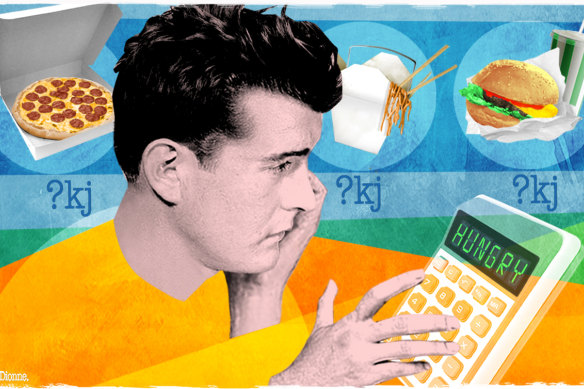This was published 7 months ago
This loophole in your food delivery app may be a hazard to your health
By Sarah Berry
In less than a decade, food delivery apps have gone from nonexistent to a multibillion-dollar industry, with Australians so hungry for their services that Uber Eats has been dubbed the “jewel in the crown” of its global operation.
By making junk foods more accessible than ever, food delivery apps have forever altered our food environment, leaving public health experts increasingly worried about the “new normal” that has been created.

Food labelling rules need an update.Credit: Dionne Gain
Back in 2011, when Uber Eats and many other platforms were but a twinkle in their founders’ eyes, state governments around the country introduced menu labelling laws requiring large fast-food outlets to display both the average energy content (as kilojoules) on menu items and the reference statement, “The average daily energy intake is 8700 kJ” at point of sale.
Though single meals from fast food outlets contain up to 90 per cent of our total daily recommended energy intake, consumers greatly underestimate the energy content of fast foods.
The idea was that providing this information could help them limit their energy consumption, but a new review found labels were either absent or incomplete on in-house or third-party ordering apps.
The researchers looked at 43 large food outlets (franchises or chains with more than 20 locations in the state or 50 locations nationally) in NSW. They found less than 6 per cent of menus on food delivery apps such as Uber Eats, Menulog and the now defunct Deliveroo, had complete kilojoule labelling for all items listed.
Only 35 per cent of in-house apps for large fast-food chains, such as MyMacca’s, had complete information.
“Meal delivery apps only really became popular around 2018-19 and then really picked up during COVID,” says lead author of the research, PhD candidate Sisi Jia, from the University of Sydney’s Charles Perkins Centre. “So I think the menu labelling scheme didn’t know what a third-party platform was back then. And it hasn’t been updated yet to include these other platforms.”
This loophole means food apps can get away with not providing the required information without fear of reprisal.
Separate research, including Jia’s own, has found people rarely use online food delivery services to purchase healthy foods, which comprise less than 20 per cent of the options available.
“[People are] ordering late on a Saturday night, they’re ordering typical unhealthy foods like burgers, pizza, fried chicken,” she says. “And they’re using a lot of promotions on these apps. So we know that they’re not good for our health, but they’re so accessible and so convenient.”
But, nutrition labels do encourage small improvements in the choices people make. This matters when overweight and obesity affects at least 25 per cent of Australian children and 67 per cent of adults.
An Uber Eats spokesperson said they would continue to expand their restaurant offerings – they currently have 50,000 – “while also using enhanced product design to help customers easily navigate to selections they’re interested in and to surface information that is important to them”.
The George Institute for Global Health food policy research fellow Damian Maganja said the findings are similar to the inconsistencies they have seen in online supermarkets.

Research has found people rarely use online food delivery services to purchase healthy foods.Credit: Edwina Pickles
“Honest labelling can help people make informed decisions about the food they’re buying, but it’s not much use if that information isn’t easily visible or available at all,” said Maganja, who was not involved with the new study.
Jia and her colleagues advise people against using delivery services frequently (once a week or more) and say their findings highlight the need to update public health nutrition policies on menu labelling to include the digital food environment.
“The NSW Government is working hand in hand with all jurisdictions on a coordinated national approach to menu labelling,” said Tara Moriarty from the office of minister for agriculture.
“In November 2022, it was recognised by all states and territories that a national approach to menu labelling was required and agreed on the development of a policy guideline.
“Food Standards Australia New Zealand have been requested to prepare a proposal for a food regulatory measure for menu labelling under the Australia New Zealand Food Standards Code.”
Make the most of your health, relationships, fitness and nutrition with our Live Well newsletter. Get it in your inbox every Monday.